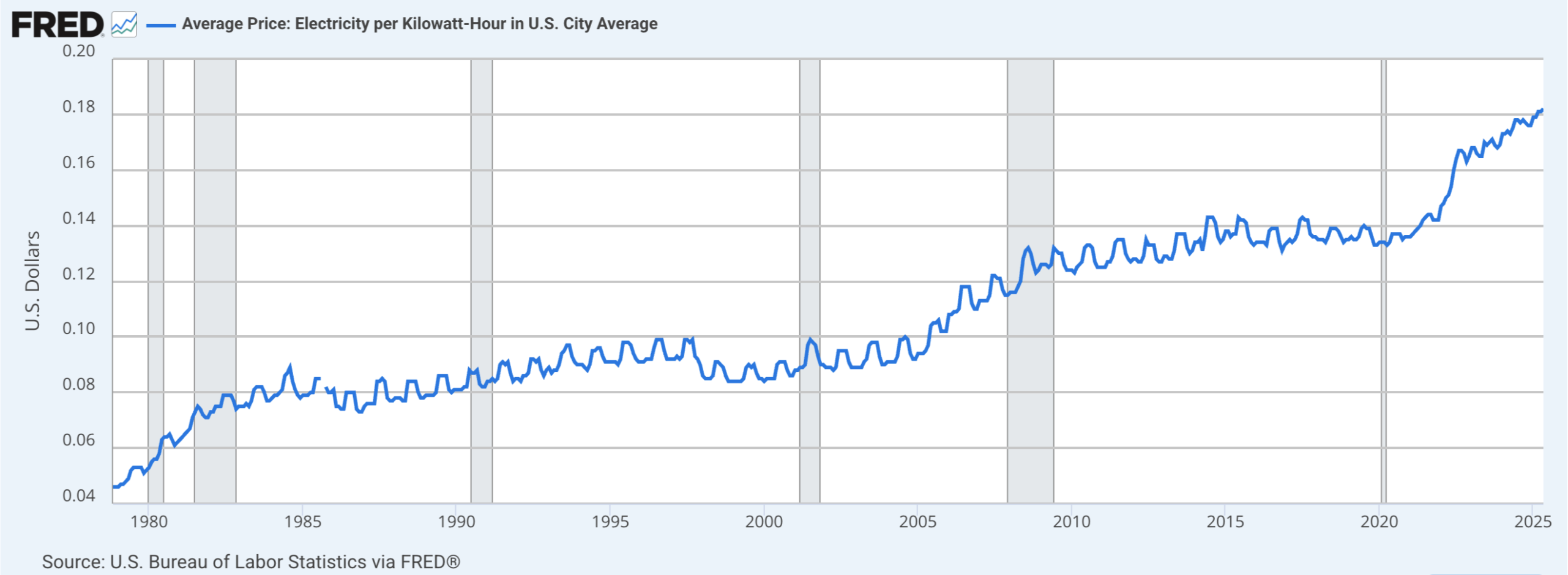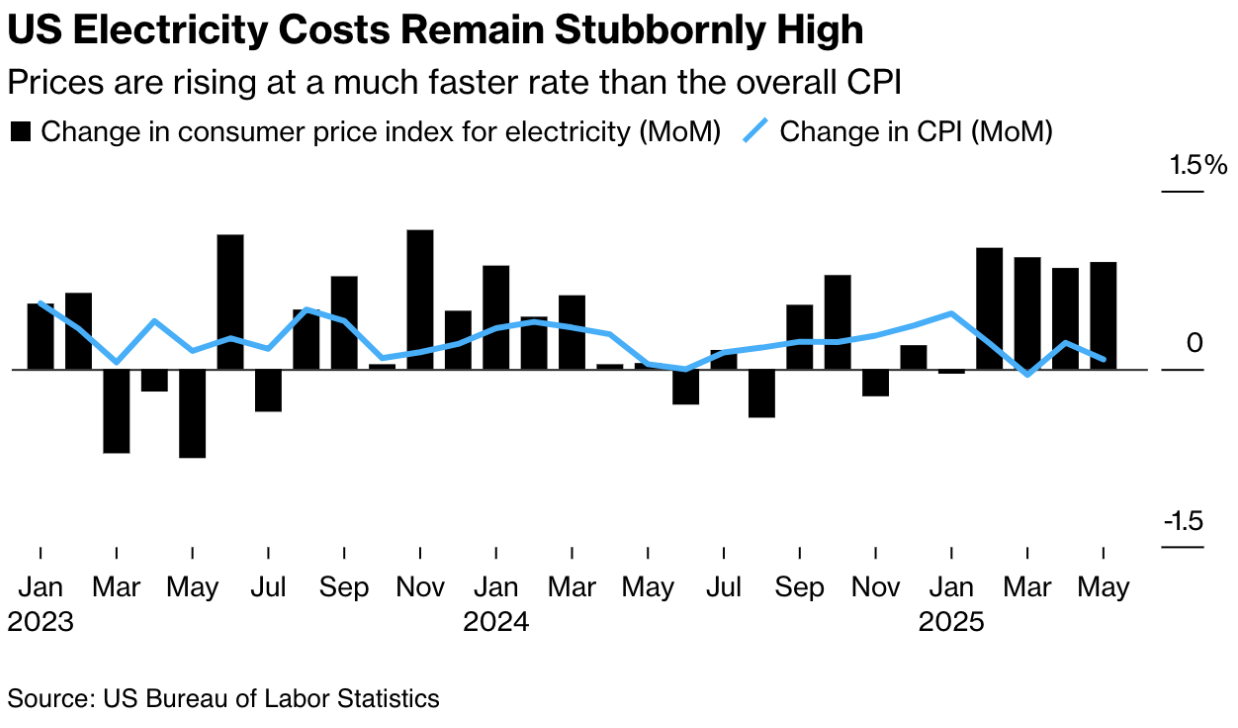Is the AI Boom Fueling an Electricity Price Surge?
June 23, 2025
Data centers alone are projected to consume 12% of the national grid by 2028. Power prices are rising quickly, but renewables like solar and wind offer a scalable, cost-effective solution. The real challenge is accelerating deployment to keep pace with AI-driven demand.
Innovo is building the digital infrastructure that makes this acceleration possible. It connects projects, data, and stakeholders to unlock faster, smarter clean energy deployment.
What's driving higher electricity prices?
Between 2021 and 2023, egg prices rose over 50% due to supply shocks. Now, electricity prices are rising along the same curve. In the past 12 months alone, U.S. residential electricity rates increased by 4.5%, nearly double the 2.3% growth of the broader Consumer Price Index, according to Bureau of Labor Statistics data. Some states like Illinois and Virginia are already seeing even steeper increases.
The surge in power prices is driven by a classic economic formula: higher demand meets constrained supply. Two sectors are fueling most of the new load: data centers and domestic manufacturing. Both sectors require massive amounts of round-the-clock electricity. When paired with aging grid infrastructure and limited new capacity, the result is tighter margins and higher consumer prices.
When electricity demand grows faster than supply, prices rise. Utilities must purchase more expensive short-term power or invest in emergency capacity upgrades. These costs are passed on to ratepayers. As more regions approach their grid limits, particularly in tech and manufacturing hubs, bill increases are likely to continue.

How much of the demand spike is from data centers?
AI is increasing electricity use rapidly, with data centers now among the largest contributors to new demand. On PJM Interconnection, the nation's biggest power grid, data center growth added $9.3 billion in costs. In Virginia, which hosts the largest concentration of data centers in the world, household electricity prices are expected to rise 26% by 2030 and 41% by 2040 due to rising digital infrastructure loads.
Data centers used 4.4% of U.S. electricity in 2023 and are forecasted to reach 12% by 2028, according to the Department of Energy. The International Energy Agency projects that globally, data centers and AI could consume 4% of all electricity by 2030. That’s more than the annual usage of some developed countries.
How much energy does AI use per prompt?
Estimates suggest a single ChatGPT query consumes about 0.34 watt-hours of electricity, roughly equal to running an oven for one second. This number, cited by OpenAI’s CEO Sam Altman, is not universally accepted. A 2024 study published in Frontiers in Communication found that some open-source language models use up to 50% more energy, especially during complex reasoning tasks.
The AI industry lacks standardized metrics for energy use or emissions. Unlike cars, which come with clear fuel economy ratings, AI tools provide no public efficiency disclosures. Climate researcher Sasha Luccioni described the gap: “You can buy a car and know the miles per gallon. With AI, we have no idea.”
What else is driving the energy crisis?
AI is a major factor, but other forces are also pushing the grid to its limits:
- Manufacturing is expanding and driving up electricity use.
- Climate-related disasters are damaging grid infrastructure and raising repair costs.
- Record-breaking demand growth puts the reliability of the grid at risk
The result is a basic supply-demand imbalance. More demand plus tight supply leads to higher prices.
Can renewable energy help reduce electricity prices?
Yes, renewables are a critical part of the solution. Unlike fossil fuels, solar and wind have no fuel costs and offer long-term price stability. In 2024 alone:
- Wind energy output increased by 8%
- Solar generation surged 25%
- Total U.S. energy production reached a record 103 quadrillion BTUs
These gains show that renewables are capable of meeting large-scale energy needs. Solar and wind are now the lowest-cost sources of new power in many regions. With storage included, the potential is even greater.
Investor interest in clean energy is growing. According to Lazard’s 2024 Levelized Cost of Energy report, utility-scale solar and onshore wind remain the least expensive sources of new electricity generation. Even before tax credits, their costs undercut new gas or coal plants.
The International Energy Agency projects $2.2 trillion will be invested in renewable power in 2025. That is more than twice the expected investment in fossil fuels. The shift reflects growing confidence in renewables as both a climate solution and a strong economic opportunity.
Clean energy can support the high loads required by AI, especially when paired with modern infrastructure. The solution depends on:
- Smart grid upgrades
- Clean power procurement by data-intensive companies
- Improved energy efficiency across AI hardware and operations
Aligning AI growth with sustainable power sources will ensure the technology can scale without overwhelming the grid or the environment.
What’s the bottom line?

AI is transforming how we use electricity. Power demand is rising and the grid is under pressure. However, wind, solar, and storage offer a clear path forward. The key is to invest in infrastructure and accelerate renewable deployment. If we do, we can meet the needs of the AI era with affordable, clean, and reliable energy.
Companies like Innovo are actively working on transacting energy more quickly, securely, and cost-effectively. In an era where AI is straining the grid and global competitiveness depends on power availability, speed is essential.